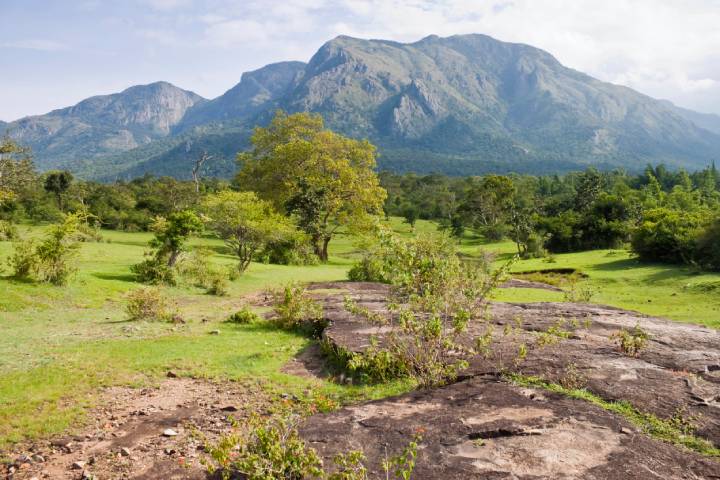From the Mighty Himalayas in the North to the captivating landscapes of the South, India has numerous National parks with flourishing wildlife, beautiful landscapes, and serene surroundings. Of them, the Top 10 National Parks in India are always special due to their diverse flora and fauna, which create breathtaking views and wildlife experiences.
There are 106 National Parks in India, covering 1.35% of India’s geographical area. Of them, here are the details of the Top 10 National Parks in India, explaining their wildlife, landscapes, Safaris, conservation efforts, and the captivating experiences they offer.
| National Park | State | Best Time to Visit | Year of Establishment | Area in km2 |
|---|---|---|---|---|
| Jim Corbett National Park | Uttarakhand | July – September | 1936 | 520 |
| Kaziranga National Park | Assam | November – April | 1974 | 858 |
| Sundarbans National Park | West Bengal | October – March | 1984 | 1330 |
| Gir National Park | Gujarat | October – March | 1975 | 258 |
| Ranthambore National Park | Rajasthan | October – May | 1973 | 282 |
| Kanha National Park | Madhya Pradesh | October – June | 1955 | 940 |
| Periyar National Park | Kerala | October – May | 1982 | 350 |
| Valley of Flowers National Park | Uttarakhand | May-September | 1982 | 87 |
| Mudumalai National Park | Tamil Nadu | September -May | 1990 | 103 |
| Hemis National Park | Ladakh | June – October for Trecks, December – February to spot snow leopards | 1981 | 3221 |
Source for year and area: MoEF&CC, Ministry of Environment, Forest and Climate Change, Government of India
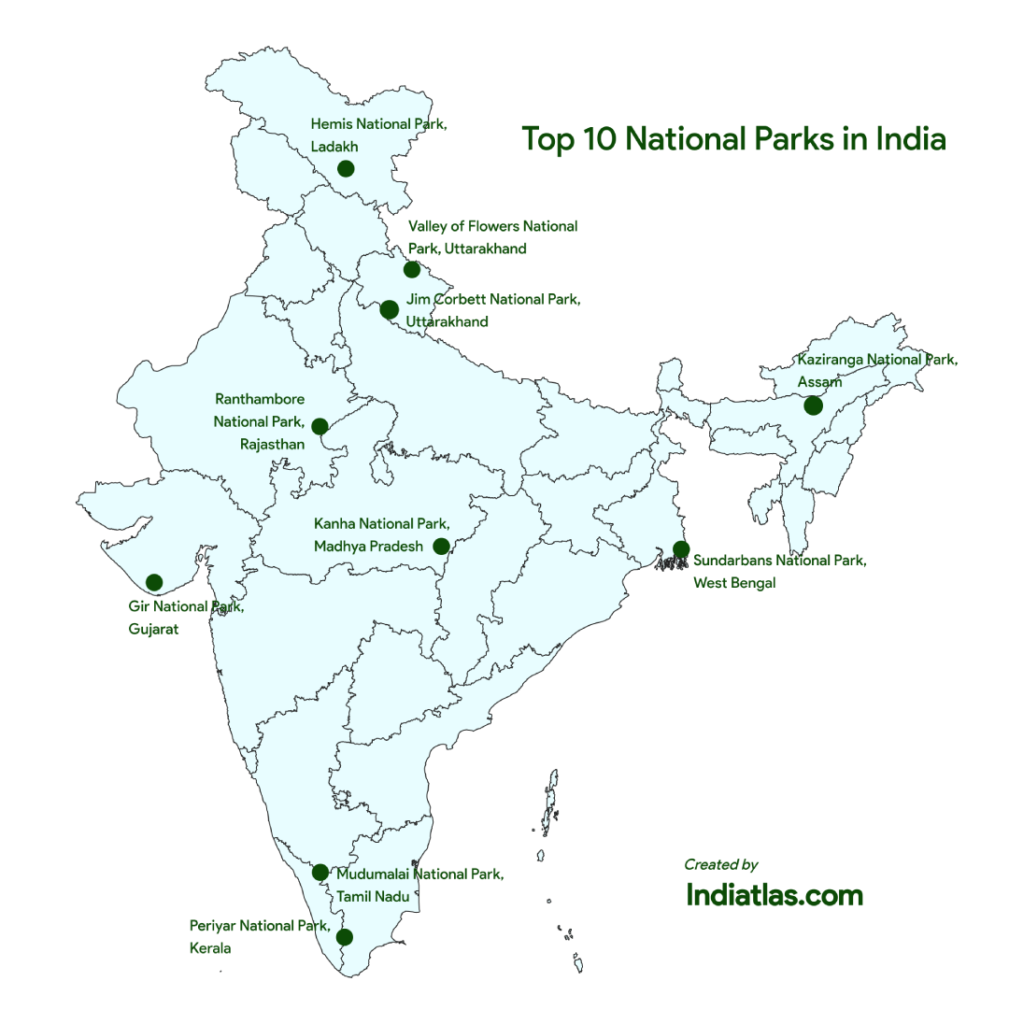
1. Jim Corbett National Park, Uttarakhand
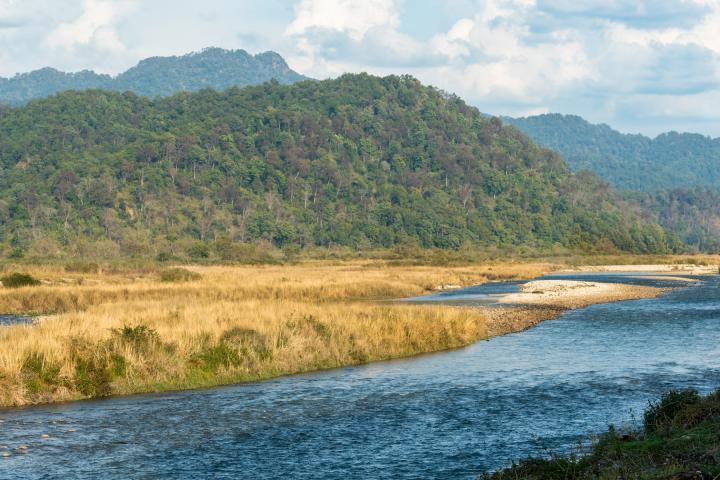
Named after the legendary conservationist Jim Corbett, this National Park present in the Himalayan foothills is home to the largest number of tigers among all the National Parks in India.
Jim Corbett National Park is the first National Park in India. Initially, it was established in 1936 as Hailey National Park, but later renamed in 1957 as Jim Corbett, considering his crucial role in establishing this park.
Jim Corbett National Park with an area of 520 km² (Square kilometres), hosts over 580 species of birds and animals. It includes the Majestic Bengal Tiger, Indian Elephant, Sloth Bear, Himalayan Black Bear, Leopard, and several deer species.
Not just for its diverse range of wildlife, it is also known for fishing and angling, making Jim Corbett National Park stand number one among the Top 10 National Parks in India.
The landscape of this national park varies from dense forests to grassy meadows and flowing rivers to beautiful creeks.
With its great wildlife safaris and incredible diversity of flora and fauna, Jim Corbett Park became a popular destination for tourists and attracted 3.53 lakh visitors in 2023-24.
An interesting fact about this National Park is that it is India’s first National Park and the first one to come under the Project Tiger initiative.
This park has five main safari zones. The Dhikala zone is open year-round, while the other zones (Birjani, Jhirna, Dhela, and Durga) are closed during monsoons.
2. Kaziranga National Park, Assam
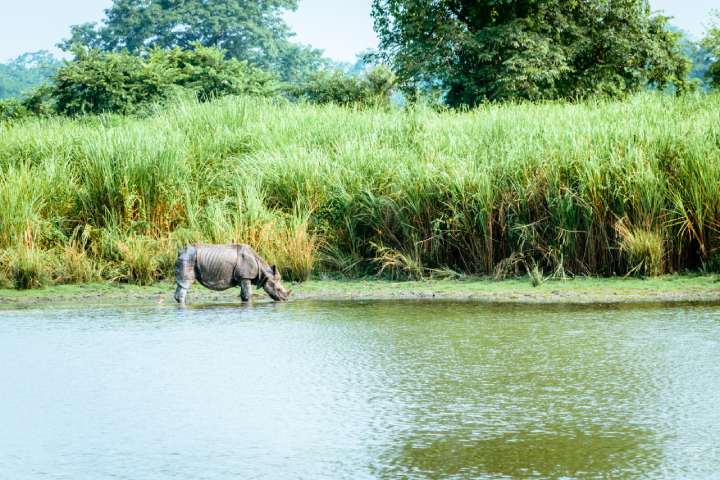
Located in Assam, Kaziranga National Park is one of the finest wildlife refuges in the World and is recognized by UNESCO as a World Heritage Site.
This National Park is very popular for being home to the world’s largest population of one-horned Rhinoceros and also the endangered Ganges River dolphins.
Apart from these, this park is home to several wildlife species like tigers, elephants, swamp deer’s, wild buffalos, and over 500 species of birds, including several endangered ones.
This park consists of grasslands, wetlands, and dense forests and even includes large areas of floodplains as the Brahmaputra River passes through this park.
The Kaziranga National Park covers an area of 858 km². The park’s conservation efforts to protect the one-horned Rhinoceros from the brink of extinction are well known.
Due to the park’s rich biodiversity, Elephant rides, wildlife safaris, and bird-watching tours are extremely popular in this National Park.
3. Sundarbans National Park, West Bengal
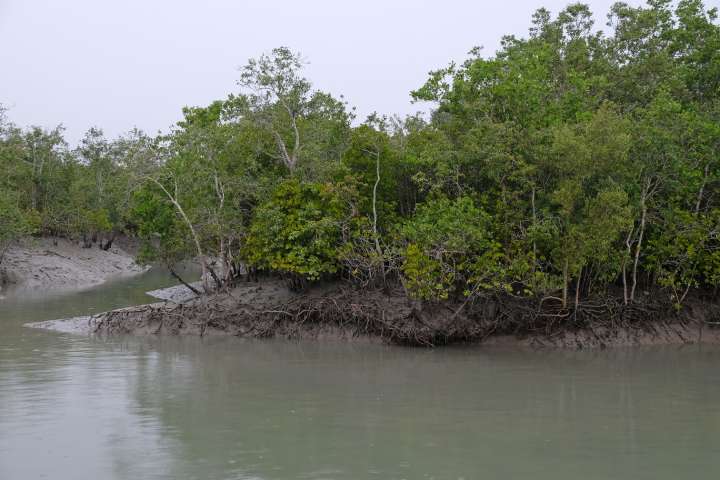
Home to the World’s largest mangrove forest, Sundarbans National Park is rich in biodiversity and is considered the most biologically productive Habitat on the planet.
This National Park covers an area of 1330 km² and is located at the confluence of two great rivers, Ganges, and Brahmaputra, which have created great waterways across the Mangrove forests.
The confluence of rivers, mangroves, the Bay of Bengal, and the mud flats created a unique ecosystem supporting diverse plant and animal species.
Sundarbans National Park is home to the endangered Bengal Tiger. It is estimated that this park has around one hundred Bengal Tigers, which are the park’s main attraction.
Other wildlife includes saltwater crocodiles, Leopard cats, Spotted deer, Pangolins, and wild boars.
Tourists can explore this beautiful National Park and the mangrove forests through Boat Safaris.
An interesting thing about Sundarbans is that some parts of this park fall under Bangladesh.
It is an exciting location for photography and nature enthusiasts.
4. Gir National Park, Gujarat
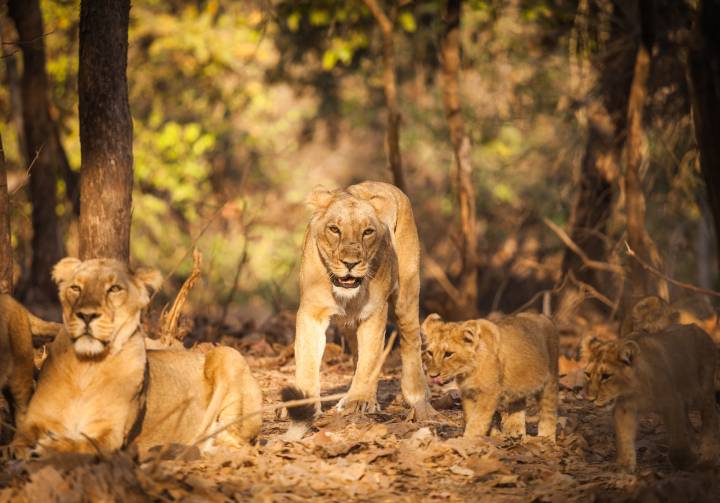
The Gir National Park in Gujarat is home to the Asiatic Lions and is the only place in India where these mystic animals can be seen in the wild.
The Indian government established this National Park in 1965 to protect the declining population of lions. Due to the conservation steps taken, Gir National Park is home to over 500 lions today.
This National Park, with an area of 258 km2, has a semi-arid climate. Its habitat includes deciduous Dry Teak Forests and Rocky Hills.
This park has more than 300 species of birds, making it a paradise to bird watchers, 132 tree species, and animals like Leopard, Hyaena, spotted deer, sambar, bluebull, and wild boar, besides the Asiatic Lions.
Tourists can visit the Safari Park and enjoy observing lions and other animals in specially designed buses or by Guided jeep safaris in Gir.
5. Ranthambore National Park, Rajasthan
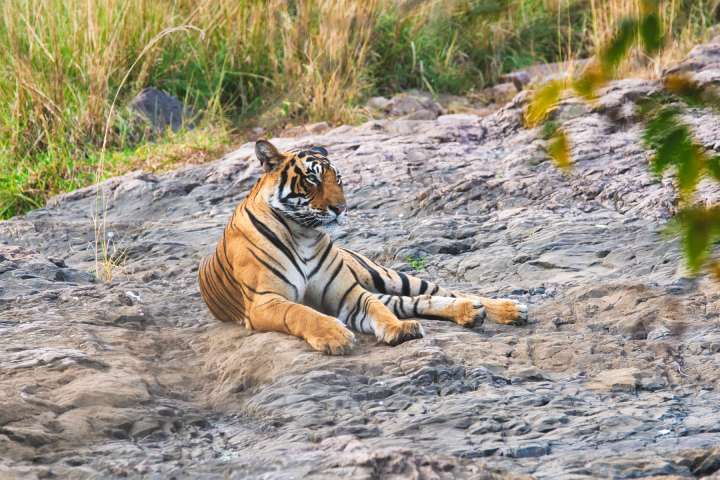
Established in 1980, The Ranthambore National Park is one of its kind in India to spot tigers in their Natural Habitat.
Located in Rajasthan, this park covers an area of about 282 km² and is a former royal hunting reserve for the Maharajas of Jaipur.
The beautiful landscape in the lap of the Aravali and Vindhya ranges, with cliffs, hills, and open meadows, made it a perfect habitat for a wide range of wildlife.
Besides Tigers, Ranthambore National Park is home to other animals like Leopards, Striped Hyaena, marsh crocodiles, Golden Jackal, Spotted deer, Caracal, Indian Fox, False Vampire bats, and more.
Visitors can explore this Park by Jeep Safaris to experience the thrill of spotting the Tigers and seeing other wildlife and landscapes.
6. Kanha National Park, Madhya Pradesh

Present in Madhya Pradesh, The Kanha National Park is one of the well-managed wildlife National parks in India. There are significant population of Bengal Tigers in this Park.
Covering an area of 940 km², the landscape of this National Park consists of dense forests, grasslands, and luxurious meadows, making it among the Top 10 National Parks in India.
Moreover, this park has a vast richness and diversity in its flora and fauna, making it a breathtaking destination for nature lovers.
Together, the Kanha National Park offers an incredible sightseeing experience. It was the inspiration for Rudyard Kipling’s masterpiece, The Jungle Book.
This National Park is home to wildlife species like Gaur (Indian Bison), Hyaena, Leopard, Wild dog, Ratel, Porcupine, Bear, Indian wolf, and various species of deer.
Visitors can also enjoy bird watching, as this park houses around 300 bird species, including Hawk Eagle, Asian woolly-necked stork, flycatchers, and a variety of Vultures.
The Park authorities organize Jeep safaris and elephant safaris through which visitors can explore the park and enjoy watching the wildlife and landscapes.
7. Periyar National Park, Kerala

Being one of the popular National Parks in southern part of India, Periyar National Park is a captivating destination known for its scenic landscapes and diverse wildlife.
Established in 1982, this park is well known for its significant population of Asian Elephants and is visited by over 7 Lakh (0.7 million) visitors annually.
In 1934, The Maharaja of Travancore initiated the first official wildlife and biodiversity conservation program in the state of Kerala. By declaring some part of the current-day National Park a private reserve to stop the encroachment of tea plantations. Later, it became a wildlife sanctuary.
These 350 km2 (Square kilometres) of National Park are home to several animals like Asian elephants, Tigers, Sambar, barking deer, Wild boars, Mouse Deer, and Monitor Lizard.
It is also home to 338 species of resident and migratory birds like the Malabar Grey Hornbill, Racket-tailed Drongo, and Blue-winged Parakeet.
This park offers several activities for visitors, such as boat rides, guided jungle walks, and bamboo rafting, of which the boat rides are the most popular.
Apart from these, the Periyar National Park also offers cultural experiences by organizing special programs with the Indigenous tribal communities.
8. Valley of Flowers National Park, Uttarakhand
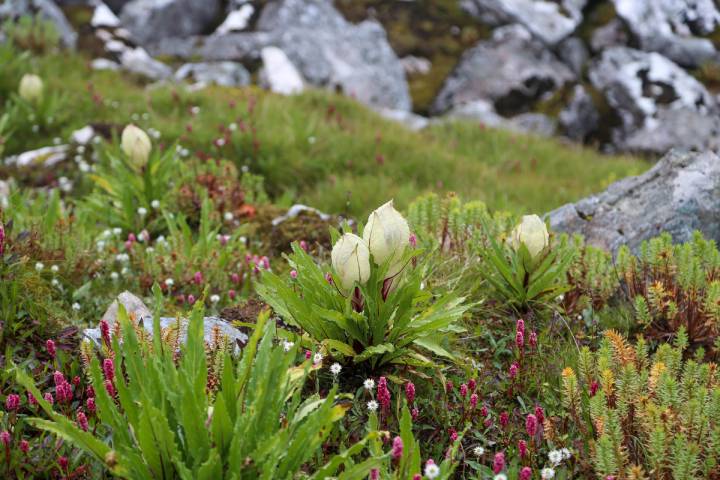
Located in Uttarakhand’s Chamoli District, Valley of Flowers National Park is an 87 km² park that is well-known for its vibrant alpine floral meadows.
This park is home to more than 650 species of flowers like blue poppy, cobra lily, Brahma kamal, and rare Himalayan flower species.
The scenic floral beauty is the fullest from June to September due to the colourful alpine blooms.
Apart from its floral beauty, This National Park is home to many endangered animals like the musk deer, snow leopard, red fox, blue sheep, and Asiatic black bear. Also, visitors can see high-altitude birds like the Himalayan monal pheasant here.
Due to all these, This Valley of Flowers National Park became a popular destination for nature enthusiasts, trekkers, botanists, bird watchers, and so on.
Due to the restricted access, visitors need to obtain permits from the forest department in the town of Govindghat.
9. Mudumalai National Park, Tamil Nadu

With its Lush green forests and over 500 species of animals, Birds, and reptiles, the scenic beauty of Mudumalai National Park is almost like a green paradise.
This National Park is located in Tamil Nadu’s Nilgiri district and on the borders of Tamil Nadu and Karnataka, covering an area of 103 km².
It is home to several animals like tigers, Asian elephants, gaur, wild dogs, four-horned antelope, and grey Langur.
Visitors can explore this park through jeep safaris and guided tours. This park also has several watchtowers and viewpoints from which you can enjoy the great scenic views of the forest and its wildlife.
An interesting thing about this National Park is that it is located in the centre between Wayanad Wildlife Sanctuary to its south and both Bandipur and Nagarhole National Parks to the North.
10. Hemis National Park, Ladakh
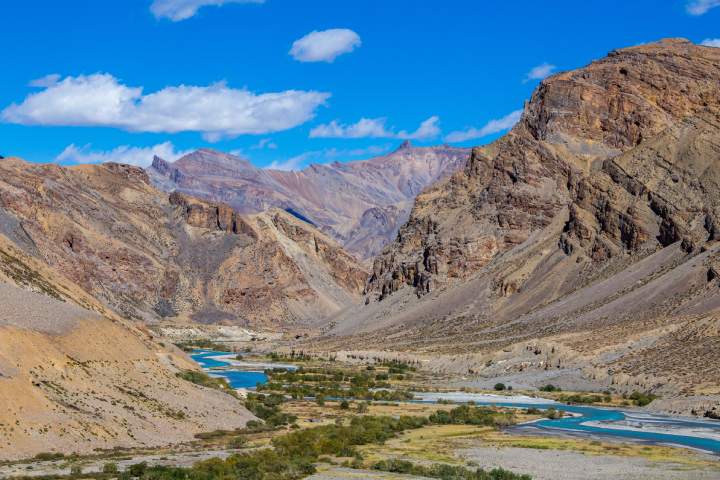
The Hemis National Park is a high-altitude national park located in the Leh district of Ladakh and is a prime attraction in the Ladakh region. The park got its name due to the Hemis Monastery situated within its borders.
Hemis National Park is the largest National Park in India covering an area of 3221 km² (square kilometres). The upper mountain slopes are characterized by alpine vegetation, while the other parts of the park support steppe vegetation. Overall, the park has rugged terrain, deep valleys, slopes, and alpine meadows.
Snow Leopards and Bharals (Blue sheep) are some of the animals in this National Park that gave global recognition to this protected area. Currently, this park has a population of 200 snow leopards.
Other endangered species in this National Park include the Tibetan wolf, Redfox, and Brown bear.
This park is a great attraction for trekkers and wildlife enthusiasts. Tourists can explore it on guided tours and wildlife safaris.
However, the park remains closed during winter due to heavy snowfall.
Visitor permits for entering the Hemis Nation Park can be obtained from the wildlife department in Leh.
